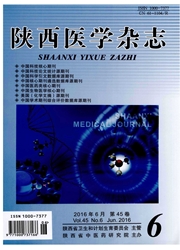

 中文摘要:
中文摘要:
目的:探究显微镜下后路微创减压微侵袭治疗ChiariⅠ型畸形的临床效果。方法:选择ChiariⅠ型畸形患者50例,按随机数表法分为对照组和观察组各25例。对照组患者实施后路减压后颅凹成型术治疗,观察组患者实施显微镜下后路微创减压微侵袭治疗。比较两组患者临床疗效,术后6个月、1年脊髓空洞情况以及术后并发症发生情况。结果:观察组患者临床疗效(96.0%)优于对照组(68.0%),差异有统计学意义(P〈0.05);两组患者术后6个月、1年脊髓空洞情况比较,无明显统计学差异(P〉0.05);观察组脑脊液漏、血象异常、枕颈部疼痛、伤口或颅内感染等并发症总发生率(12.0%)低于对照组(36.0%),差异有统计学意义(P〈0.05)。结论:对ChiariⅠ型畸形患者实施显微镜下后路微创减压微侵袭治疗效果显著,能提高患者临床疗效,且术后并发症发生率较小,安全性高。
 英文摘要:
英文摘要:
Objective:To investigate the clinical effect of minimally invasive treatment with posterior spinal decompression under microscope for typeⅠChiari malformation.Methods:50 patients with typeⅠChiari malformation were divided into control group and observation group by random number table, 25 cases in each.Control group took posterior cranial fossa decompression, observation group took minimally invasive treatment with posterior spinal decompression under microscope.The clinical efficacy, syringomyelia situation and postoperative complications after surgery for 6 months and 1 year of two groups were compared.Results:The clinical efficacy of observation group was better than control group (P〈0.05);There was no significant difference in the syringomyelia situation after surgery for 6 months and 1 year between the two groups (P〈0.05);The total incidence of cerebrospinal leak, abnormal blood picture, neck pain, wound or intracranial infection in observation group was lower than control group (P〈0.05).Conclusion:Minimally invasive treatment with posterior spinal decompression under microscope for typeⅠChiari malformation has significant effects, it can increase clinical efficacy with low incidence of postoperative complications and high safety, which has higher value of clinical application.
 同期刊论文项目
同期刊论文项目
 同项目期刊论文
同项目期刊论文
 期刊信息
期刊信息
